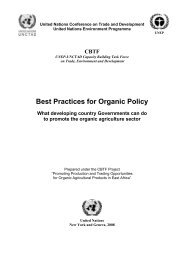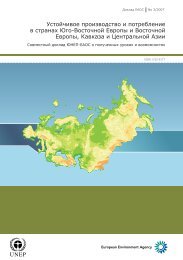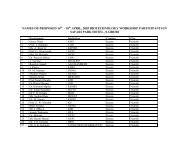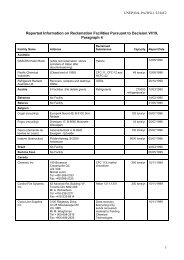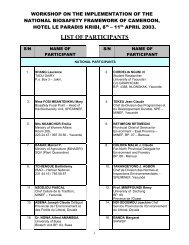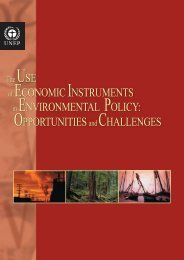Regional Seas: Strategies for sustainable development - UNEP
Regional Seas: Strategies for sustainable development - UNEP
Regional Seas: Strategies for sustainable development - UNEP
You also want an ePaper? Increase the reach of your titles
YUMPU automatically turns print PDFs into web optimized ePapers that Google loves.
This is an ambitious strategy, so we have had to decide where to best apply our energies and resources<br />
over the next few years.<br />
At the top of our list of priorities is capacity-building to meet the threat of oil spills. After wide<br />
consultation we have planned a programme of seminars and training courses to help member countries<br />
become better able to implement the <strong>Regional</strong> Oil Contingency Plan and to develop their own national<br />
plans. We will also work with them to develop their port reception facilities under the MARPOL Convention<br />
and to set up a <strong>Regional</strong> Activity Centre to oversee this work.<br />
Another focus will be our work with member countries on National Action Plans and pilot programmes<br />
to implement the Global Programme of Action <strong>for</strong> the Protection of the Marine Environment from Landbased<br />
Activities (GPA). Our third immediate priority is environmental assessment and monitoring, including<br />
the data collection and management that this entails.<br />
Along with the other regional programmes, we find ourselves confronted with the great challenges<br />
and opportunities offered by the new in<strong>for</strong>mation technologies, and in this regard we will be working with<br />
<strong>UNEP</strong>’s World Conservation Monitoring Centre to develop our own capacities as well as those of our member<br />
countries. If our environmental ef<strong>for</strong>ts are to succeed, this will probably be the key to our success.<br />
Looking down the road, we feel that <strong>Regional</strong> Activity Centres will be the cornerstone of a successful<br />
programme. As such, our ultimate goal will be to set up such centres in each of our member countries,<br />
each dealing with with one of our action plan priorities, namely oil spill contingency planning, integrated<br />
coastal zone management, land-based sources, biodiversity, and assessment and monitoring.<br />
Prasantha Dias Abeyegunawardene, Deputy Director Programmes,<br />
South Asia Cooperative Environment Programme (SACEP)<br />
North-East Pacific<br />
The Central American coastline of the North-East Pacific hosts a variety of habitats including mangrove<br />
swamps, productive fishing grounds, and species-rich <strong>for</strong>ests that extend to the water’s edge. Millions of<br />
people depend on these ecosystems and their resources <strong>for</strong> food, construction materials and income from<br />
tourism-related industries.<br />
Over 90% of the population of Central America lives on this drier Pacific side, and so it is here where<br />
the environmental pressures are the greatest. Forest clearance, over-exploitation of resources, expanding<br />
maritime trade, rapid <strong>development</strong> and political conflict are rampant. The result has been widespread loss<br />
of plant and animal species, degraded and eroded soils, destruction of biodiversity-rich mangrove areas<br />
and pollution of both coastal and inland waters.<br />
Pollution from the land is made potentially even more damaging in<br />
the region because of the numerous sheltered bays and gulfs where the<br />
natural dispersal of oil and toxic chemicals is inhibited. The region is also<br />
an important shipping route <strong>for</strong> vessels sailing from Panama to Alaska,<br />
and much of the oil transported from Alaska to the east coast of America<br />
transits the Panama Canal or the Laguna de Chiriqui oil pipeline.<br />
Moreover, the region still has a troubled legacy to overcome. In the<br />
1980s, Central America was gripped by a profound political and economic<br />
crisis marked by an accumulated 18.3% decline of per capita gross<br />
domestic product. The end of the Cold War a decade ago may have ended<br />
the major conflicts afflicting the region, but its legacy of poverty endures.<br />
These many problems present a <strong>for</strong>midable challenge which the<br />
countries of the region are determined to meet. In February 2002, history<br />
was made with the signature in La Antigua , Guatemala, of the Convention<br />
<strong>for</strong> Cooperation in the Protection and Sustainable Development of the<br />
Marine and Coastal Environment of the North-East Pacific.<br />
.<br />
28




